| Columns Retired Columns & Blogs |
Sennheiser HD 800 S: Tweaked and Delightful...and a French DIY Response
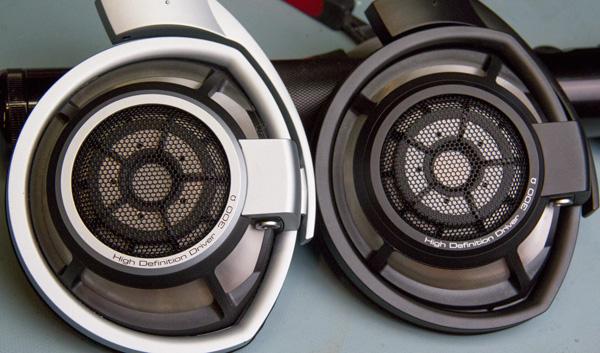
This story originally appeared at InnerFidelity.com
Sennheiser HD 800 (left) and newly evolved HD 800 S (right).
Sennheiser HD 800 S ($1699)
When introduced in 2009, the Sennheiser HD 800 rapidly became recognized as one of the world's best headphones, having unbelievably good transient response and detail retrieval, spectacular imaging, and being competitive with the best electrostatics and planar magnetics—having some trade-offs here and there.
But the HD 800 is also quite problematic. It has a sharp sounding peak at around 6kHz that will, at times and with problematic recordings, drill a bleeding hole in your eardrums. Adding to this problem is an overall cool response, lacking the bass extension that, say, an Audeze LCD planar magnetic can has.
I'm not going to do a traditional InnerFidelity headphone review here; the new HD 800 S is very much like its predecessor only changing a few small acoustic tweaks, and being dressed in a black livery—a look I like very much. So, if you want to read about styling, comfort, and build quality—all of which are terrific—you can look at my previous HD 800 review here and just imagine it in black. Oh, and with two cables: one with standard 1/4" plug; and the other with a 4-pin XLR for balanced use.
In this article, I'm going to bring out exactly what I've found as the acoustic differences between the HD 800 and HD 800 S. And! I'm going to tell you about a very cool modification you can do to an old HD 800 to get some of the benefits found in the new HD 800 S. Grab a cuppa, sit back, and enjoy, I promise this will be an interesting read.
Acoustic Changes to the HD 800 S
Sennheiser, from what I can tell, has done two things to the HD 800 S to improve its sound quality: Damped the spike in response at 6kHz, and warmed up the headphone a bit. We'll take them one at a time.
Killing the 6kHz Spike
Right after I published my HD 800 review, I also published what was termed at the time "The Anaxilus Mod", which intended to damp the 6kHz spike by putting felt in certain positions in the earcup of the HD 800 to reduce its ability to resonate. This mod has evolved over time and it seems lives on in this SBAF thread.
The problem with adding a bunch of damping material in the ear cup is that it's not particularly selective about what frequencies get attenuated. If the problem at 6kHz is narrow-band, well, using a solution that's narrow-band makes more sense than wide-bandwidth absorbing material.
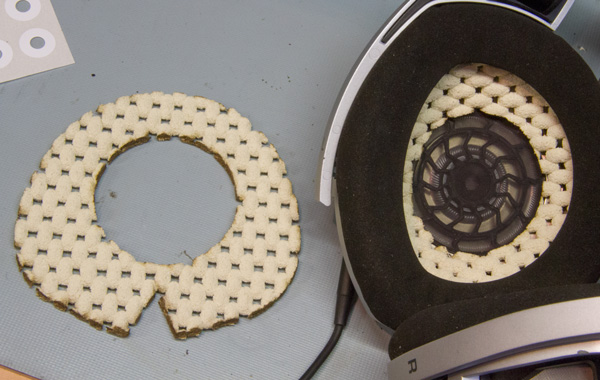
Current SuperBAF mod using a specific rug liner material to damp the earcup.
I need to note here that the materials now being recommended by HD 800 modders at this point are not simply wide-band absorbing felt. Many, many materials have been tried and measured. The current material of choice is somewhat elastic and has regularly repeating holes (see photo above)—both of these characteristic may give the material a degree of selectivity in what frequencies are attenuated, and may also be a source of spurious secondary emission of sound.
Sennheiser, being the smarty-pants engineers they are—and I say that with a great deal of affection—took the alternate route of engineering what, it seems to me, is a narrow-band Helmhotz resonator into the opening at the center of the driver. Essentially a surgical attack, providing a tightly tuned anti-resonance at 6kHz.
Helmhotz resonators have been around since 1850 when Hermann von Helmholtz exhaled a sharp sigh of relief after finishing a bottle of poor brew and heard the bottle emit a tone...Ha! No, sorry, I have no idea how he figured it out.
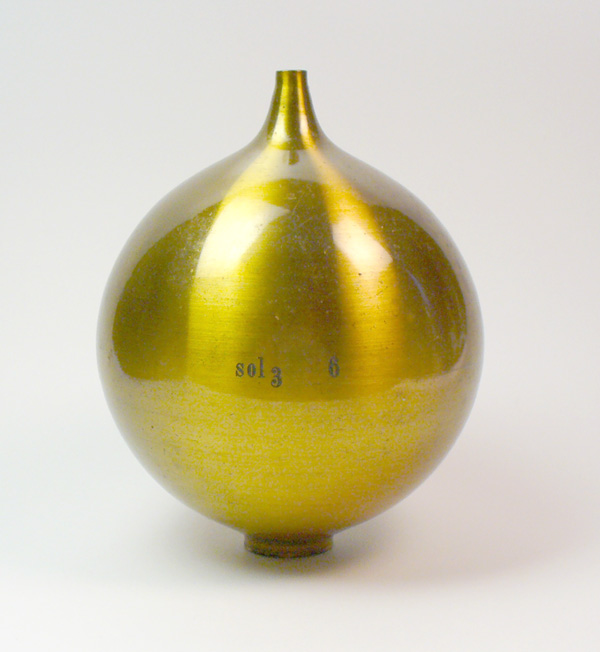
He invented these cool looking resonators, and observed that if you stuck the bottle neck and hole into your ears, the resonator would amplify the frequencies near the resonators natural resonance and damp other frequencies. He went on to make a variety of sizes of the resonators and, when presented with a sound, each bottle would resonate with certain ranges of the sound presented. Measuring the amount of sound resonating in each bottle would permit a crude method for measuring the spectral frequency content of the sound. Amazingly, this was one of the first audio frequency response measurement system. Here's the Wiki for Helmhotz Resonance.
I was fascinated to learn that one of the most common modern uses of Helmholtz resonators are in engine exhaust systems. Resonators are built into the muffler and tune the "exhaust note" of the system. Want to bring out the growl of a V8? Tune it with a resonator. But it's also important to know that you can use these resonators to tune out a frequency. Want your Benz to whoosh silently down the road? Tune out the noise with resonators.
Basically, if you use the right resonator in the right place it can be anti-resonant with the tone of interest. Imagine the sine wave of an audio signal of a particular frequency of interest passing by the opening of the resonator. At the top of the sine wave, high pressure enters the bottle, which then bounces of the inside of the bottle at the resonant frequency, and the high pressure returns to the opening of the bottle one half wavelength later. Well, the original sound is now one half wavelength from its previous maximum and is now at the low point of the sine wave. So, you now have the low point of the sine wave meeting the high point of the wave as it exits the bottle delayed by a half wavelength, and the two cancel. In other words: Helmholtz resonators can be used either to amplify or cancel particular frequencies.
The new HD 800 S has, as far as I can tell, a Helmholtz resonator—or something very much like it; there are variations on this theme like 1/4 and 1/2 wave resonators—built right into the center opening of the driver on the inside of the headphones. And this resonator, from what I can tell through measurements, is anti-resonant to the 6kHz spike generated by the acoustics of the earcup enclosure. Measurements show that the HD 800 S does precisely damp the problem.
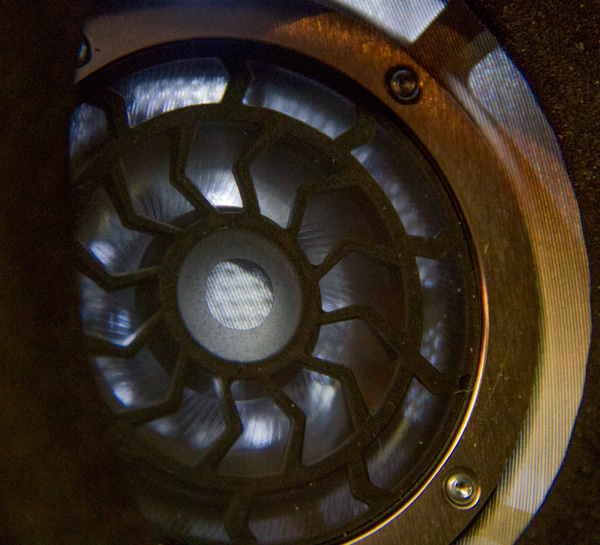
In the photo above, I'm shining a flashlight in through the back of an HD 800 S. There's a fine screen mesh over the entire front of the driver up to the screwed down metal ring. This mesh has a small donut of air impermeable material partially closing the space behind it in the central hole. You can equate this to the neck and opening of the resonator. In the bottom of the well there's a mesh screen that looks identical to the HD 800 from the outside, but as I closely inspected it, it does seem that there's an additional layer of screen at the bottom of the hole on the inside. I think this screen may act as the bottom of the closed bottle, but does allow some air to pass slightly diminishing the amplitude of resonance for a given input. I think controlling the permeability of this layer at the bottom is used by the engineers at Sennheiser to adjust the damping to the right level. Caution: A lot of guesswork going on here.
The important thing to note is that the enclosed chamber of this resonator is completely empty...just like the beer bottle you can blow across. If you put damping material—like the batting inside speakers—into the bottle, it would become much harder to get a clear tone out of the bottle. The damping material would "spoil the Q" (damping the ringing bell-like quality) of the resonator. So, a surgical strike on the peak at 6kHz by the Sennheiser engineers. Well done!
Warming the HD 800 S
No onto a bit tougher problem: Making the HD 800 S a little warmer and more inviting—even with the fix to the 6kHz spike the headphone remains a bit cool. This is really tough to fix for an open acoustic design. With sealed headphones you can use the sealed chamber of the ear cup to contain the pressure of the long low-note wavelengths and boost the bass some. With open headphones, the driver usually has a primary resonance between 60 and 150Hz (it's about 110Hz on the HD 800), below the primary driver resonance, driver efficiency will evermore reduce as frequency lowers. The result is loss of low frequency extension. Bottom line: there's not much Sennheiser can do to increase bass response of the HD 800.
But! There's a little trick you can do to increase perceived bass response in low frequency limited devices: Add second harmonic distortion to the low notes to "bloom" them up a bit. This is often done in the Bluetooth portable speakers, which, due to their small drivers and overall small size, have problems reaching way down into the bass. By selectively adding 2nd harmonic overtones to the low notes, overall bass energy is increased—albeit at a higher frequency than the original tone—and your perception will be a euphonic warming of the bass. It's euphonic because the second harmonic is exactly an octave above the primary tone, so it remains in harmony with the original music. On the other hand, it is a distortion, and those with well trained ears will hear the bass as slightly less precise and authoritative.
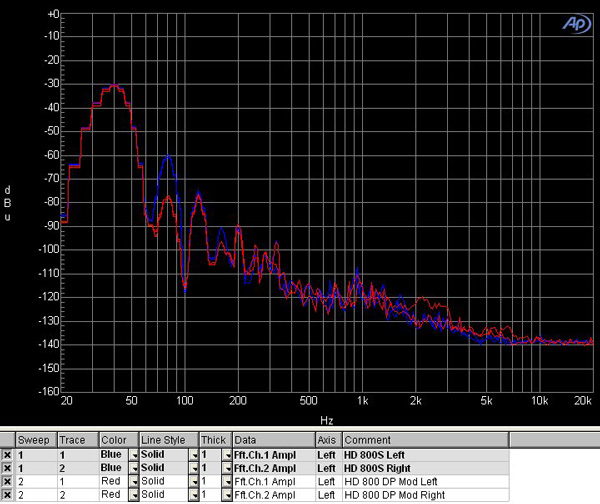
The plot above shows the spectra content of an HD 800 S and HD 800 reproducing a 40Hz sine wave. As you can see, the second harmonic at 80Hz has 20dB more amplitude than the 2nd harmonic of the HD 800. The third harmonic at 120Hz is about the same; the fourth harmonic at 160Hz is about 3dB louder on the HD 800 S.
Editor's Note: When I first saw an increase in distortion of the HD 800 S over the HD 800, I wanted to make sure it wasn't just a problem with the one HD 800 S I had at hand. Neither Todd the Vinyl Junkie nor HeadRoom had any left, the U.S. PR rep had none either. I immediately went over to superbestaudiofriends.org and asked for some help. Members TMoney and Dr. Higgs volunteered their new HD 800 S headphones, which I arranged to have shipped overnight. Upon receipt I did repeat my measurements and found these headphones to perform essentially identically to the pair I initially tested. My experience is that Sennheiser has great quality control with unit to unit variation being very low...but I did triple check, and my measurements for all three were very similar.
The first observation I'd like to make here is that there's a thought in audio that the best sounding gear should have a nice, asymptotically reducing level of the harmonic series. In other words: The level of the harmonics should reduce smoothly with each subsequent harmonic being lower than its predecessor. You can see in the plot above that the level of the second and third harmonics are are roughly the same on the HD 800, which, according to this rule, would not be optimal. With the HD 800 S the second, third, and fourth harmonics are ever smaller. This might indeed be a preferable tuning. I do have to note that the fifth harmonic at 200Hz is higher than the fourth in both headphones; this may not be desirable, but it also may be one of those things that Sennheiser engineers likely can't adress without screwing up something more audible. It's 60dB down from the fundamental tone, so it's likely not an audible problem.
And now, the big question...
HD 800 S Sound Quality
For me, the HD 800 S delivers a markedly more pleasant listening experience than the HD 800. The piercing treble problem has been reduced to insignificance and replaced by a marvelously articulate and responsive presentation of the treble. And the overall tonality of the HD 800 S is indeed noticeably warmer and more inviting; the bass is more present in the mix.
But, I do hear the bass as a little less precise in the HD 800 S, having a bit more pleasant bloom, but also being just a tad growly and congested, calling attention to itself. Please understand that I use "just a tad" very specifically here; these headphones don't have noticeably distorted bass; it's just noticeably warm and inviting, but less clear and pure than the HD 800. On the other hand, the HD 800 bass level is a bit too low, and the headphones are cooler sounding than I would prefer.
So, did Sennheiser make a good decision trading off a little added distortion for better tonality? Yes, you bet, I'd much prefer to listen to the new HD 800 S over the stock HD 800. Much. This is where small objective differences can make disproportionately large subjective improvements. I find the new HD 800 S much easier on the ears....musical even, but with clarity taking a front seat over euphony, which seems unusual and very cool to me.
My last note on HD 800 S sound quality is something that has persisted in both the new and original model. The upper-mid-range is a bit withdrawn causing voices to loose some of their natural overtones making them seem a bit more distant. Though I need less bass and treble adjustments when I EQ the HD 800 S, I find I still need a bit of boost centered around 1kHz.
Speaking of EQ, when I listen to the two headphones EQed, I think I tend to prefer the old HD 800, but it's close. With the HD 800 S I find myself being somewhat cautious about my bass level setting—bringing it up to where I like it does make the distortion a bit more obvious. On the other hand, I can tweak out a notch at 6kHz to try to tame the spike in the old HD 800, but the resonance is still there in the headphones, and if a signal gets hot around 6kHz then you can hear it zinging. Niether are perfect, but I think I prefer having to fiddle with the 6kHz notch a bit based on the music playing rather than not being able to dial the bass up to where I want it without lows becoming a bit too congested. However, if I wasn't using EQ, I'd easily prefer the HD 800 S.
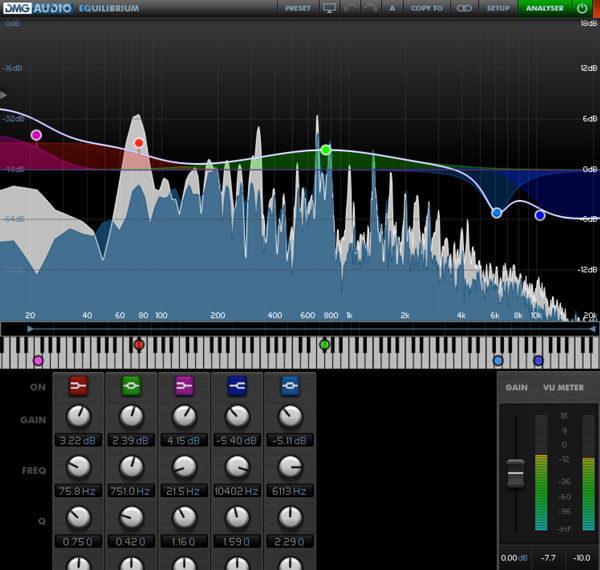
My EQ settings for the HD 800.
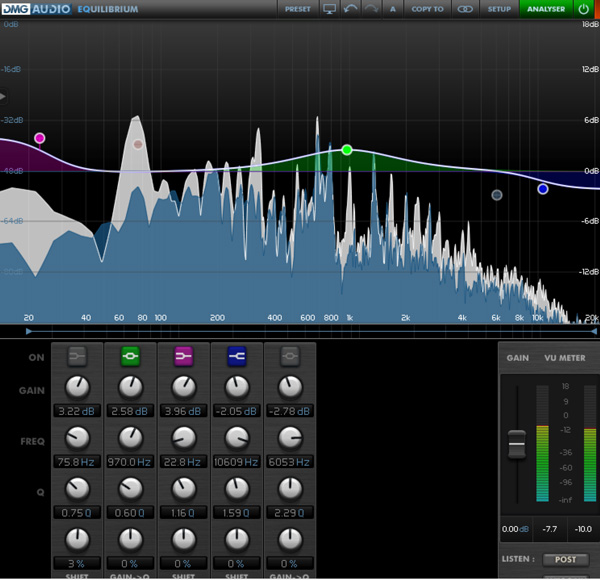
My EQ settings for the HD 800S.
There are other options though, if you're willing to take the risk. Let's flip the page and see what the DIYers are doing.
- Log in or register to post comments




































